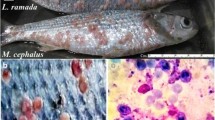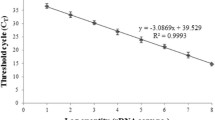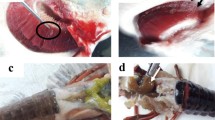Abstract
A life-threatening emaciation disease of unknown cause(s) is affecting the farming of olive flounders (Paralichthys olivaceus) and turbots (Scophthalmus maximus) on Jeju Island, Korea. As this is one of the major industries in the region, it is of great concern to local farmers trying to develop successful and sustainable aquaculture. We examined 16 olive flounders and one turbot cultured at three farms located in the southern part of Jeju Island, which manifested moderate to severe emaciation such as thinning of the body with notable appearance of bony ridges of the skull on heads. Fresh mucosal scrapings of the intestinal mucosa contained many myxosporean vegetative stages at various developments but not fully grown spores. Histological examination of gastrointestinal and other visceral organs revealed striking changes in the intestinal mucosa such as detachment and loss of the epithelium due to intensive parasitism of the myxosporean vegetative stages, accompanied by considerable leukocyte infiltration in the lamina propria, and at the final stage villus atrophy with no epithelial lining. Specific polymerase chain reaction using a pair of primers targeting a fragment of the 18S ribosomal RNA gene (rDNA) of Enteromyxum leei, a known pathogen causing myxosporean emaciation disease in a variety of cultured fish in Mediterranean countries and Japan, amplified 433-bp products in almost all diseased fish samples, particularly the gastrointestinal tract. Nearly the whole length of the 18S rDNA, 1672-bp long excluding primer-aligning sequences, of the present Korean isolate was comparable to those of E. leei isolates from Japan and Europe, particularly those from the former region. Taking the heavy load of various developmental stages of E. leei in the gastrointestinal mucosa into account, we ascribe the emaciation disease of the fish examined in the present study to this well-known myxosporean species and not to another unknown pathogen(s).


Similar content being viewed by others
References
Abdel-Ghaffar F, Abdel-Baki AS, Bayoumy EM, Bashtar A-R, Al-Quraishy S, Morsy KS, Alghamdy A, Mehlhorn H (2008a) Light and electron microscopic study on Henneguya suprabranchiae Landsberg, 1987 (Myxozoa: Myxosporea) infecting Oreochromis niloticus, a new host record. Parasitol Res 103:609–617
Abdel-Ghaffar F, Ali MA, Al Quraishy S, Entzeroth R, Abdel-Baki AS, Al Farraj S, Bashtar A-R (2008b) Zschokkella helmii n.sp. (Myxozoa: Myxosporea), a new parasite of marble spinefoot Siganus rivulatus (Forsskal 1775), Red Sea, Egypt: light and transmission electron microscopy. Paasitol Res 102:183–192
Ali MA, Abdel-Baki AS, Abdel-Ghaffar F (2007) Zschokkella egyptica n. sp. (Myxosporea : Bivalvulaida) infecting the gallbladder of the eel catfish Plotosus lineatus Thunberg, 1787 and the freckled goatfish Upeneus tragula Richardson, 1846 in the Red Sea, Egypt. Parasitol Res 100:625–628
Alvarez-Pellitero P, Sitjà-Bobadilla A (1993) Pathology of Myxosporea in marine fish culture. Dis Aquat Org 17:229–238
Alvarez-Pellitero P, Palenzuela O, Sitjà-Bobadilla A (2008) Histopathology and cellular response in Enteromyxum leei (Myxozoa) infections of Diplodus puntazzo (Teleostei). Parasitol Int 57:110–120
Athanassopoulou F, Prapas T, Rodger H (1999) Diseases of Puntazzo puntazzo Cuvier in marine aquaculture systems in Greece. J Fish Dis 22:215–218
Branson E, Riaza A, Alvarez-Pellitero P (1999) Myxosporean infection causing intestinal disease in farmed turbot, Scophthalmus maximus (L.), (Teleostei: Scophthalmidae). J Fish Dis 22:395–399
China M, Nakamura H, Hamakawa K, Tamaki E, Miwa S, Meng F, Yokoyama H (2013) Occurrence of the myxosporean emaciation disease caused by Enteromyxum leei in cultured Malabar grouper Epinephelus malabaricus. Fish Pathol 48:88–96 (in Japanese with English summary)
Cho JB, Kim KH (2004) Light and electron microscopical observations of Parvicapsula anisocaudata (Myxosporea: Parvicapsulidae) from urinary system of cultured olive flounder, Paralichtys olivaceus. J Fish Pathol 17:179–189
Choi HS, Jun LJ, Kim SM, Jeong HD, Kim YK, Lim H, Yeo I, Jeong JB (2012) Clinical features of fish with pathogens isolated from emaciated olive flounder Paralichthys olivaceus. J Fish Pathol 25:67–76 (in Korean with English summary)
Cuadrado M, Marques A, Diamant A, Sitjà-Bobadilla A, Palenzuela O, Alvarez- Pellitero P, Padrós F, Crespo S (2008) Ultrastructure of Enteromyxum leei (Diamant, Lom, & Dyková) (Myxozoa), an enteric parasite infecting gilthead sea bream (Sparus aurata) and sharpsnout sea bream (Diplodus puntazzo). J Eukaryot Microbiol 55:178–184
Diamant A (1997) Fish-to-fish transmission of a marine myxosporean. Dis Aquat Org 30:99–105
Diamant A (1998) Red drum Sciaenops ocellatus (Sciaenidae), a recent introduction to Mediterranean mariculture, is susceptible to Myxidium leei (Myxosporea). Aquaculture 162:33–39
Diamant A, Lom J, Dyková I (1994) Myxidium leei n. sp., a pathogenic myxosporean of cultured sea bream Sparus aurata. Dis Aquat Org 20:137–141
Diamant A, Ram S, Paperna I (2006) Experimental transmission of Enteromyxum leei to freshwater fish. Dis Aquat Org 72:171–178
Dyková L, Lom J (1988) Review of pathogenic myxosporeans in intensive culture of carp (Cyprinus carpio) in Europe. Folia Parasitol 35:289–307
Estensoro I, Redondo MJ, Alvarz-Pellitero P, Sitjà-Bobadilla A (2010) Novel horizontal transmission route for Enteromyxum leei (Myxozoa) by anal intubation of gilthead sea bream Sparus aurata. Dis Aquat Org 92:51–58
Fleurance R, Sauvegrain C, Marques A, Le Breton A, Guereaud C, Cherel Y, Wyers M (2008) Histopathological changes caused by Enteromyxum leei infection in farmed sea bream Sparus aurata. Dis Aquat Org 79:219–228
Hallett SL, Bartholomew JL (2012) Myxobolus cerebralis and Ceratomyxa shasta. In: Woo PTK, Buchmann K (eds) Fish parasites: pathobiology and protection. CAB International, Oxford, pp 131–162
Ishimatsu A, Hayashi M, Nakane M, Sameshima M (2007) Pathophysiology of cultured tiger puffer Takifugu rubripes suffering from the myxosporean emaciation disease. Fish Pathol 42:211–217
Katharios P, Rigos G, Divanach P (2011) Enteromyxum leei (Myxozoa), a lethal intruder of tropical pet fish: first case in humphead wrasse, Cheilinus undulates (Rüppell, 1835). J Exot Pet Med 20:138–143
Katharios P, Kokkari C, Sterioti A, Smyrli M, Kalatzis PG (2014) Enteromyxum leei infection in parrotfish, Sparisoma cretense: histopathological, morphological and molecular study. Vet Parasitol 199:136–143
Kent ML (1999) A myxozoan resembling Myxidium leei in the anemone fish Amphiprion frenatus from the Pacific Ocean. Bull Eur Assoc Fish Pathol 19:42–43
Kent ML, Andree KB, Bartholomew JB, El-Matbouli M, Desser SS, Devlin RH, Feist SW, Hedrick RP, Hoffman RW, Khattra J, Hallett SL, Lester JG, Longshaw M, Palenzuela O, Siddall ME, Xiao C (2001) Recent advances in our knowledge of the Myxozoa. J Eukaryot Microbiol 48:395–413
Kim YK, Jeong JB, Lee MK, Park SI, Park MA, Choe MK, Yeo IK (2011) Pathophysiology of olive flounder Paralichthys olivaceus suffering from emaciation. J Fish Pathol 24:11–18 (in Korean with English summary)
Kim SM, Jun LJ, Park MA, Jeong HD, Jeong JB (2015) Characterization of the myxosporean parasie isolated from emaciated olive flounders Paralichthys olivaceus on Jeju Island. Korean J Fish Aquat Sci 48:337–345 (in Korean with English summary)
Le Breton A, Marques A (1995) Occurrence of an histozoic Myxidium infection in two marine cultured species: Puntazzo puntazzo C. and Pagrus major. Bull Eur Assoc Fish Pathol 15:210–212
Li Y-C, Sato H, Kamata Y, Ohnishi T, Sugita-Konish Y (2012) Three novel myxobolid species of genera Henneguya and Myxobolus (Myxosporea: Bivalvulida) from marine fish in Japan. Parasitol Res 111:819–826
Montero FE, Cuadrado M, Padrós F, Crespo S, Raga JA (2007) Cryptocaryon irritans and Enteromyxum leei, two threats for the culture of Diplodus puntazzo in the Mediterranean. Bull Eur Assoc Fish Pathol 27:242–249
Molnár K (2002) Differences between the European carp (Cyprinus carpio carpio) and the coloured carp (Cyprinus carpio haematopterus) in susceptibility to Thelohanellus nikolskii (Myxosporea) infection. Acta Vet Hung 50:51–57
Morsy K, Abdel-Ghaffar F, Bashtar AR, Mehlhorn H, Al Quraishy S, Abdel-Gaber R (2012) Morphology and small subunit ribosomal DNA sequence of Henneguya suprabranchiae (Myxozoa), a parasite of the catfish Clarias gariepinus (Clariidae) from the River Nile, Egypt. Parasitol Res 111:1423–1435
Ogawa K, Yokoyama H (2001) Emaciation disease of cultured tiger puffer Takifugu rubripes. Bull Natul Res Inst Aquacult, Suppl 5:65–70
Özer A, Öztürk T, Özkan H, Çam A (2014) First report of Enteromyxum leei (Myxozoa) in the Black Sea in a potential reservoir host Chromis chromis. Fish Pathol 49:57–60
Padrós F, Palenzuela O, Hispano C, Tosas O, Zarza C, Crespo S, Alvarez-Pellitero P (2001) Myxidium leei (Myxozoa) infections in aquarium-reared Mediterranean fish species. Dis Aquat Org 47:57–62
Palenzuela O (2006) Mixozoan infections in Mediterranean mariculture. Parassitologia 48:27–29
Palenzuela O, Redondo MJ, Álvarez-Pellitero P (2002) Description of Enteromyxum scophthalmi gen. nov., sp. nov. (Myxozoa), an intestinal parasite of turbot (Scophthalmus maximus L.) using morphological and ribosomal RNA sequence data. Parasitology 124:369–379
Pote LMW, Khoo L, Griffin M (2012) Henneguya ictaluri. In: Woo PTK, Buchmann K (eds) Fish parasites: pathobiology and protection. CAB International, Oxford, pp 177–192
Quiroga MI, Redondo MJ, Sitjà-Bobadilla A, Palenzuela O, Riaza A, Macías A, Vázquez S, Perez A, Nieto JM, Alvarez-Pellitero P (2006) Risk factors associated with Enteromyxum scophthalmi (Myxozoa) infection in cultured turbot, Scophthalmus maximus. Parasitology 133:433–442
Redondo MJ, Palenzuela O, Riaza A, Macias Á, Álvarz-Pellitero P (2002) Experimental transmission of Enteromyxum scophthalmi (Myxozoa), an enteric parasite of turbot Scophthalmus maximus. J Parasitol 88:482–488
Redondo MJ, Palenzuela O, Alvarz-Pellitero P (2003) In vitro studies on viability and proliferation of Enteromyxum scophthalmi (Myxozoa), an enteric parasite of cultured turbot Scophthalmus maximus. Dis Aquat Org 55:133–144
Redondo MJ, Palenzuela O, Alvarz-Pellitero P (2004) Studies on transmission and life cycle of Enteromyxum scophthalmi (Myxozoa), an enteric parasite of turbot Scophthalmus maximus. Folia Parasitol 51:188–198
Rigos G, Katharios P (2010) Pathological obstacles of newly-introduced fish species in Mediterranean mariculture: a review. Rev Fish Biol Fisheries 20:47–70
Rigos G, Christophilogiannis P, Yiagnisi M, Andriopoulou A, Koutsodimou M, Nengas I, Alexis M (1999) Myxosporean infections in Greek mariculture. Aquacult Int 7:361–364
Sitjà-Bobadilla A, Palenzuela O (2012) Enteromyxum species. In: Woo PTK, Buchmann K (eds) Fish parasites: pathobiology and protection. CAB International, Oxford, pp 163–176
Sitjà-Bobadilla A, Diamant A, Palenzuela O, Alvarez-Pellitero P (2007) Effect of host factors and experimental conditions on the horizontal transmission of Enteromyxum leei (Myxozoa) to gilthead sea bream, Sparus aurata L., and European sea bass, Dicentrarchus labrax (L.). J Fish Dis 30:243–250
Tun T, Yokoyama H, Ogawa K, Wakabayashi H (2000) Myxosporeans and their hyperparasitic microsporeans in the intestine of emaciated tiger puffer. Fish Pathol 35:145–156
Tun T, Ogawa K, Wakabayashi H (2002) Pathological changes induced by three myxosporeans in the intestine of cultured tiger puffer, Takifugu rubripes (Temminck and Schlegel). J Fish Dis 25:63–72
Yanagida T, Nomura Y, Kimura T, Fukuda Y, Yokoyama H, Ogawa K (2004) Molecular and morphological redescriptions of enteric myxozoans, Enteromyxum leei (formerly Myxidium sp. TP) and Enteromyxum fugu comb. n. (syn. Myxidiium fugu) from cultured tiger puffer. Fish Pathol 39:137–143
Yanagida T, Freeman MA, Nomura Y, Takami I, Sugihara Y, Yokoyama H, Ogawa K (2005) Development of a PCR-based method for the detection of enteric myxozoans causing the emaciation disease of cultured tiger puffer. Fish Pathol 40:23–28
Yanagida T, Sameshima M, Nasu H, Yokoyama H, Ogawa K (2006) Temperature effects on the development of Enteromyxum spp. (Myxozoa) in experimentally infected tiger puffer, Takifugu rubripes (Temminck & Schlegel). J Fish Dis 29:561–567
Yanagida T, Plaenzuela O, Hirae T, Tanaka S, Yokoyama H, Ogawa K (2008) Myxosporean emaciation disease of cultured red sea bream Pagrus major and spotted knifejaw Oplegnathus punctatus. Fish Pathol 43:45–48
Yasuda H, Ooyama T, Iwata K, Tun T, Yokoyama H, Ogawa K (2002) Fish-to-fish transmission of Myxidium spp. (Myxozoa) in cultured tiger puffer suffering from emaciation disease. Fish Pathol 37:29–33
Yasuda H, Ooyama T, Nakamura A, Iwata K, Palenzuela O, Yokoyama H (2005) Occurrence of the myxosporean emaciation disease caused by Enteromyxum leei in cultured Japanese flounder Paralichthys olivaceus. Fish Pathol 40:175–180
Yokoyama H, Shirakashi S (2007) Evaluation of hyposalinity treatment on infection with Enteromyxum leei (Myxozoa) using anemonefish Amphiprion spp. as experimental host. Bull Eur Assoc Fish Pathol 27:74–78
Yokoyama H, Kageyama M, Yanagida T, Ogawa K (2009) Seawater survival of Enteromyxum leei (Myxozoa) evaluated by in vitro viability and in vivo infectivity assays. Fish Pathol 44:172–177
Yoon GH (2008) Aquaculture in Korea. Aquacult News 34:16–17
Acknowledgments
We are indebted to Ms. Ji-Hyeon Ahn, Daebong LS, Ltd. for her Korean–Japanese translation. This study was supported in part by Grant-in-Aid for Scientific Research 2015 from the Towa Foundation for Food Science and Research (HS), by Grant-in-Aid for International Collaboration Research in Asia 2016 from the Heiwa Nakajima Foundation, and by JSPS KAKENHI Grant Number 15K07722.
Author information
Authors and Affiliations
Corresponding author
Rights and permissions
About this article
Cite this article
Sekiya, M., Setsuda, A., Sato, H. et al. Enteromyxum leei (Myxosporea: Bivalvulida) as the cause of myxosporean emaciation disease of farmed olive flounders (Paralichthys olivaceus) and a turbot (Scophthalmus maximus) on Jeju Island, Korea. Parasitol Res 115, 4229–4237 (2016). https://doi.org/10.1007/s00436-016-5200-5
Received:
Accepted:
Published:
Issue Date:
DOI: https://doi.org/10.1007/s00436-016-5200-5




